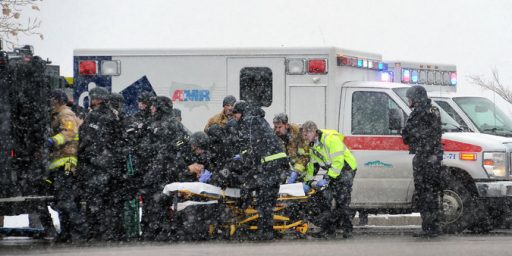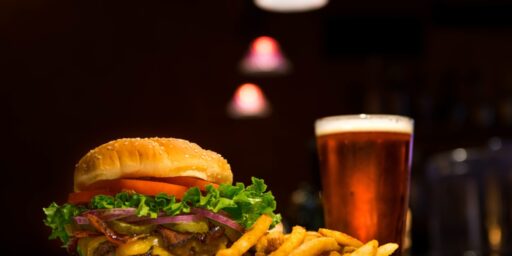McDonald’s Outsourcing Drive-Throughs
NYT – A Drive-Through Lane to the Next Time Zone [RSS]
Pull off Interstate 55 near Cape Girardeau, Mo., and into the drive-through lane of a McDonald’s next to the highway and you’ll get fast, friendly service, even though the person taking your order is not in the restaurant – or even in Missouri. The order taker is in a call center in Colorado Springs, more than 900 miles away, connected to the customer and to the workers preparing the food by high-speed data lines. Even some restaurant jobs, it seems, are not immune to outsourcing. The man who owns the Cape Girardeau restaurant, Shannon Y. Davis, has linked it and 3 other of his 12 McDonald’s franchises to the Colorado call center, which is run by another McDonald’s franchisee, Steven T. Bigari. And he did it for the same reasons that other business owners have embraced call centers: lower costs, greater speed and fewer mistakes.
Cheap, quick and reliable telecommunications lines let the order takers in Colorado Springs converse with customers in Missouri, take an electronic snapshot of them, display their order on a screen to make sure it is right, then forward the order and the photo to the restaurant kitchen. The photo is destroyed as soon as the order is completed, Mr. Bigari said. People picking up their burgers never know that their order traverses two states and bounces back before they can even start driving to the pickup window. Once he found out about the service, Mr. Davis said, he didn’t even need to think about signing up for it. He said he had dreamed of doing something like this for more than a decade. “We could not wait to go with it,” he said. Mr. Bigari, who owns 12 McDonald’s franchises and created the call center for his own restaurants, was happy to oblige – for a small fee per transaction.
The McDonald’s Corporation said it found the call center idea interesting enough to start a test with three stores near its headquarters in Oak Brook, Ill., with different software than that used by Mr. Bigari. But the company added that it was more focused on other, continuing customer service improvements, like adding wireless Web access, or Wi-Fi, to restaurants, and introducing ways to let customers pay with credit and debit cards.
Jim Sappington, a McDonald’s vice president for information technology, said that it was “way, way too early” to tell if the call center idea would work across the 13,000 McDonald’s restaurants in the United States. And there are obstacles to the spread of the system that Mr. Bigari now uses in all seven of his drive-through restaurants. The software works only with one company’s point-of-sale system, and only 7 of McDonald’s roughly 1,400 franchisees use that system. Because such systems typically cost $25,000 to $50,000 a restaurant, it may prove cheaper – though slower – for McDonald’s or other big chains to develop their own systems.
Still, franchisees of two other McDonald’s restaurants, beyond Mr. Davis’s, have outsourced their drive-through ordering to Mr. Bigari in Colorado Springs. (The other restaurants are in Brainerd, Minn., and Norwood, Mass.) Central to the system’s success, Mr. Bigari said, is the way it pairs customers’ photos with their orders; by increasing accuracy, the system cuts down on the number of complaints and therefore makes the service faster. In the fast-food business, time is truly money: shaving even five seconds off the processing time of an order is significant. Mr. Bigari said he had cut order time in his dual-lane drive-throughs by slightly more than 30 seconds, to about 1 minute, 5 seconds, on average. That’s less than half the average of 2 minutes, 36 seconds, for all McDonald’s, and among the fastest of any franchise in the country, according to QSRweb.com, which tracks such things. His drive-throughs now handle 260 cars an hour, Mr. Bigari said, 30 more than they did before he started the call center.
***
Working together, Mr. Bigari and software engineers from Exit41 put a small call center in the back of one of his restaurants in May 2003. Within a couple of weeks, the store was filling orders 30 percent faster and making fewer mistakes. Mr. Bigari quickly decided that he should set up an operation to handle other restaurants, and he now employs 53 people in the call center, which operates 24 hours a day. Though his operators earn, on average, 40 cents an hour more than his line employees, he has cut his overall labor costs by a percentage point, even as drive-through sales have increased. He said the call center saved enough in six months to cover the cost of setting it up, in part because he no longer had to employ as many people on the overnight shift.
Fascinating.





Well, if one can order a pizza online…
I wonder how soon they’ll move them to India.
I don’t think it will move to India any time soon, Joseph, for the same reason that Dell and others moved call centers back to the States from India. One of the biggest problems with drive-throughs is the language barrier, which not only impedes the accuracy of the order, but the time involved in getting the order placed. Using non-native English speakers, even non-native American-English speakers, would undermine the point behind outsourcing.
Oh, I don’t know, it seems to me that ordering a Number 4 with extra fries is not nearly so complicated as computer tech support.
And, in my town at least, most of the fine folks behind the squwak box are already from places like Guadelahara or Somalia, so I don’t thing the “foreign accent” barrier is all that serious.
It seems to me that Mickey D’s has all the freedom in the world to drive the labor costs down to the bottom of the world wide well. Which I think is the real “point” behind all outsourcing.
I’ve eaten at that McDonalds. The food and service was poor by McDonald’s standards.
Now that I’ve learned about the photo-taking, I’m going to make monster-faces while ordering at a drive-through.